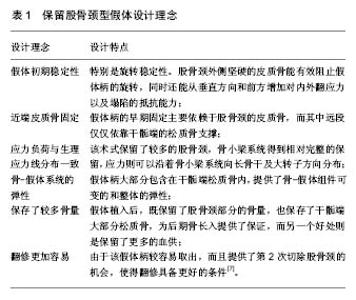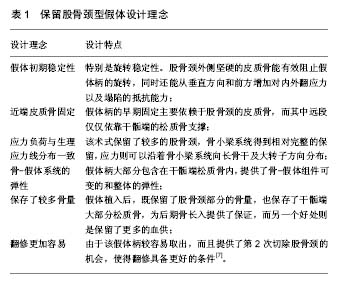Chinese Journal of Tissue Engineering Research ›› 2017, Vol. 21 ›› Issue (31): 5054-5059.doi: 10.3969/j.issn.2095-4344.2017.31.023
Previous Articles Next Articles
Total hip arthroplasty with collum femoris preserving prosthesis: differences from traditional prosthesis
Huang He-tao1, Pan Jian-ke2, Xie Hui1, Yang Wei-yi2, Liang Hao-dong1, Liu Jun2
- 1Second School of Clinical Medicine, Guangzhou University of Chinese Medicine, Guangzhou 510405, Guangdong Province, China; 2Department of Joint Surgery, the Second Affiliated Hospital of Guangzhou University of Chinese Medicine & Guangdong Provincial Hospital of Chinese Medicine, Guangzhou 510120, Guangdong Province, China
-
Online:2017-11-08Published:2017-12-01 -
Contact:Liu Jun, Chief physician, Professor, Doctoral supervisor, Department of Joint Surgery, the Second Affiliated Hospital of Guangzhou University of Chinese Medicine & Guangdong Provincial Hospital of Chinese Medicine, Guangzhou 510120, Guangdong Province, China -
About author:Huang He-tao, Studying for master’s degree, Second School of Clinical Medicine, Guangzhou University of Chinese Medicine, Guangzhou 510405, Guangdong Province, China
CLC Number:
Cite this article
Huang He-tao, Pan Jian-ke, Xie Hui, Yang Wei-yi, Liang Hao-dong, Liu Jun. Total hip arthroplasty with collum femoris preserving prosthesis: differences from traditional prosthesis[J]. Chinese Journal of Tissue Engineering Research, 2017, 21(31): 5054-5059.
share this article

2.1 纳入资料基本概况 纳入资料基本情况计算机搜索初检得到578篇文献,通过阅读文题和摘要进行初步筛选,排除质量较差或与文章主题不相关的文献,阅读全文后,根据纳入标准和排除标准,最后纳入41篇文献进行综述[1-41]。 2.2 纳入资料的研究结果特征 2.2.1 传统全髋关节置换的局限性 股骨颈是股骨的应力分布中心,股骨近端最坚实的部位。传统全髋关节置换需要切除股骨颈部分,而股骨颈的切除将极大影响股骨近端的应力平衡,亦即在人体负重时,股骨颈假体将改变原先正常作用于股骨近端的应力方向、大小和分布。正常股骨近端所承受的应力可能部分经由股骨髓腔内的假体而直接传导至股骨远端,从而造成股骨近端部分的应力遮挡现象。在全髋关节置换后,骨重建和骨丢失过程一直持续,特别是在股骨近端部分。应力遮挡是造成全髋关节置换后骨丢失的机械因素之一,而骨丢失和皮质变薄最终将导致假体固定失败[6]。异常的变应力通常会引起骨组织的自我调节和重新塑形,骨组织的生理应力刺激发生减少性改变,可进一步引起骨重建的负平衡,继而导致股骨近端正常骨量的丢失,最终诱发股骨近端的人工假体下沉、松动,并出现髋部疼痛甚至行走困难等症状。 2.2.2 保留股骨颈假体的设计理念 意大利的Pipino教授通过对人工关节外科的研究,提出了“组织保护外科”的概念,他强调在全髋关节置换中尽可能多的保留用于固定假体的健康组织。他与德国Link公司联合设计研发了保留股骨颈型假体,并于1983年应用于临床,通过长期观察,肯定了其临床效果[7-8],该假体的设计理念见表1。"


2.2.3 全髋关节置换中保留股骨颈的重要作用 股骨颈由股骨近端的“皮质骨圆柱体”构成,是股骨近端极其坚实的骨组织结构及股骨的应力分布中心,通过股骨颈可有效的将应力进一步分布到股骨大转子(张应力)和股骨距(压应力),从而实现下肢的应力分布均衡。传统的全髋关节置换需要切除股骨颈,这将导致股骨近端张应力及压应力系统的受力平衡受到严重破坏,置换后极易并发股骨假体松动、下沉等严重并发症。保留股骨颈型全髋关节置换尽可能多的保留了股骨颈的健康骨组织,进而使股骨近端应力系统保持相对平衡,这极大的减少了全髋关节置换后发生假体松动、下沉等常见并发症。无独有偶,保留股骨颈型假体使得股骨生理状态下的偏斜距得到较大限度的保留,将全髋关节置换后髋关节假体的磨损率降到最低,该假体的设计使假体柄的大部分位于皮质骨和股骨假体之间的股骨干骺端松质骨内,随之而产生的骨-假体之间的弹性模量是可变的,这对于骨组织与假体之间的结合是极有利的。股骨颈骨量得到充分保留,将为后期的二次翻修提供极大的便利。 2.2.4 保留股骨颈型假体的临床应用优势 理论而言,保留股骨颈型假体可保留股骨颈的健康骨结构,股骨颈是股骨近端最坚实的部分,将的全髋关节置换使假体应力传导更接近股骨近端原有的生理状况分布[9],即通过股应力分布到股骨大转子(张应力)和股骨距(压应力)。保留股骨颈骨颈传递应力,使应力通过骨小梁分布到股骨大转子和骺端,从而保证初始的三维稳定性,防止股骨近端骨质疏松所致假体松动及以后的大腿痛发生。生物力学研究显示,破坏性扭转实验中完全保留股骨颈的扭矩显著大于保留50%,15%以及不保留股骨颈者[10]。与传统假体比较,保留股骨颈型假体能明显减少应力遮 挡[11]。保留股骨颈可以保持生理状态下的股骨偏心距,使股骨假体的磨损降低到最小。保留股骨近端松质骨的优点是能够较好的保留骨内膜的血循环系统,研究发现,保留股骨颈可保留70%血供[12],这将为置换后远期的骨组织长入及实现股骨假体的生物性固定提供极大的保障,此外,截骨量较少也为远期可能进行的髋部翻修提供了结构基础。在使用保留股骨颈型假体的人工全髋关节置换中,髋部肌肉力线与关节力线较好的保持了髋关节的受力平衡,有效的防止了股骨假体发生内翻的倾向,使股骨近端的不良应力得以较为彻底的消除[13],对防止假体下沉也十分重要。因此,保留股骨颈型假体可能与股骨近端的生理顺应性更加符合。此外,在进行人工全髋关节翻修时,患者初次置换后剩余的骨量对二次翻修的成功率起着不可小觑的作用,保留股骨颈假体的全髋关节置换较为完整的保留了股骨颈组织,可以保存更多的骨量,为远期的二次翻修提供了较好的骨组织结构基础,手术时只需根据术中情况切除股骨颈部骨质,即可使假体柄的大部分得到充分暴露,容易取出初次全髋关节置换假体并植入新假体[14]。 传统的非保留股骨颈型修复方式需要切除股骨颈部分,这将使股骨近端压力骨小梁的连续性遭到较为严重的破坏,假体的坚强固定通常需要依靠置换后远期的骨重建来实现,而股骨颈部骨量的减少,亦不利于股骨后期的假体翻修。近年,随着患者年轻化的趋势以及对活动有更高的要求,保留股骨颈型假体的设计理念愈发受到相关学者和专家的重视。保留股骨颈型假体的设计是希望能够保留股骨颈,使其更加符合生物力学要求,并且保留了更多的骨量,为日后的翻修提供了更好的条件。 2.2.5 保留股骨颈型假体的缺点 保留股骨颈型假体可为患者目后翻修保留更多骨量,但如果术中发生假体周围骨折,则可能造成手术失败。研究表明,保留股骨颈型髋关节置换可降低髋关节置换后并发症和疼痛发生率,但在术中易出现股骨假体周围骨折,严重影响患者置换后髋关节功能恢复[15-16]。秦迪等[17]对影响保留股骨颈型假体周围骨折的相关因素进行了前瞻性随访研究,结果显示保留股骨颈型髋关节置换中骨折发生的危险因素主要主要有以下几个方面:①假体种类选择不当;②假体型号选择不当;③截骨平面选择不当;④股骨颈骨质硬化带处理不当;⑤股骨近端发育畸形。因此,详细的置换前计划和对手术风险的预估,是减少髋关节置换中假体周围骨折的关键。 2.2.6 保留股骨颈型假体全髋关节置换的适应证及禁忌证 结合保留股骨颈型假体的设计理念及生物力学研究,保留股骨颈的全髋关节置换主要适用于股骨颈相对完好、对髋部活动度要求较高、无骨质疏松、置换后远期很可能面临二次翻修的低龄患者。由于保留股骨颈假体全髋关节置换要求股骨颈保留平面位于小转子上1.5-2.0 cm,与传统全髋关节置换相比,更不利于翻修术中髋臼侧的手术操作,因此保留股骨颈的全髋关节置换不适用于需要在髋臼进行复杂重建手术的患者;此外,骨折线侵害股骨距较低水平的股骨颈骨折患者也不适合选用该术式[18]。 2.2.7 使用保留股骨颈型假体全髋关节置换适应证 保留股骨颈型全髋关节置换主要适用于股骨颈结构保存完好的股骨头坏死、原发性髋关节骨性关节炎、创伤性髋关节骨关节炎、青壮年外伤后股骨头骨折及股骨颈头下型骨折、类风湿性髋关节炎等,该术式尤适用于对髋关节活动度要求较高、远期很可能面临二次翻修的中青年患者。 2.2.8 使用保留股骨颈型假体全髋关节置换手术方法使用保留股骨颈型假体的全髋关节置换手术术式大同小异,通过总结国内外该方面的知名专家手术经验,现将最适合临床推广学习的手术步骤概述如下。麻醉方面,可根据实际选择气管插管内麻醉或硬膜外麻醉;麻醉满意后,使患者取侧卧位,髋部后外侧入路为首选入路,选择股骨大转子为骨性标志并作为顶点作髋关节后外侧切口,依次逐层切开皮肤、皮下组织、阔筋膜张肌,钝性分离患侧臀大肌纤维并切开股骨外旋肌群,充分显露髋关节外侧及转子部;切开髋关节囊,使股骨颈充分显露;全面评估股骨颈骨质情况,若股骨颈部分骨质相对良好,则行保留股骨颈型假体全髋关节置换,否则行传统全髋关节置换;于股骨头颈交界处切断股骨颈,截骨平面通常确定在股骨转子间窝向上1.5-2.0 cm处;完整取出股骨头,完整切除髋臼缘关节囊并清除髋臼周缘骨赘;结合置换前影像学资料,使用合适的髋臼锉将髋臼软骨磨锉至局部出现渗血,置入型号大小合适的髋外杯,螺钉固定髋臼外杯;将导向板钉状突起插入股骨颈内侧皮质处,确定导向板的准确定孔位置,使用扩髓器缓慢扩股骨髓腔至预定的深度,注意使用选定的髓腔锉进行逐级扩髓以扩大股骨近端骨髓腔[18];扩髓完毕后取下髓腔锉柄端,充分磨平股骨颈截骨面;依次安装试模、试颈及试头;复位髋关节后,试行活动髋关节以评估髋臼假体和股骨假体间的位置是否合适,通常在下肢中立位时头臼覆盖率最大提示较为合适;脱位髋关节,取出试模;选择合适型号的的股骨假体置入股骨髓腔,注意使股骨颈截骨面与颈领接触紧密,安装人工股骨头并进行复位;于术腔内置入负压引流,逐层缝合切口。 2.2.9 保留股骨颈假体全髋关节置换后处理 置换后使患肢保持外展位牵引,预防性使用抗生素两三天[18];注意术口充分引流,待引流量< 50 mL/d时可视情况拔除引流管;置换后尽快(建议置换后第2天)进行功能锻练,如股四头肌等长收缩训练、抬腿训练等;尽量置换后第2天摄片,评估股骨假体位置是否正常,确定假体位置正常后,可于置换后第3天开始扶拐下地进行部分负重锻炼,其后根据患者功能锻练情况、肌力恢复情况及定期X射线片决定进一步功能锻练方式。 2.2.10 保留股骨颈假体全髋关节置换注意事项 使用保留股骨颈型假体全髋关节置换手术步骤与传统全髋关节置换大相近庭,根据既往文献报道,现将保留股骨颈全髋关节置换注意事项总结如下:①严格把握适应证,置换前需进行全面影像学测量评估,防止因选择的假体柄过大而导致股骨干劈裂;②研究表明,髋部后外侧入路具有切口小、软组织损伤小、围置换期出血少、置换时间短、置换后恢复快、住院时间短等诸多优点[19];③注意截骨面的位置选择,术中既要避免股骨颈骨质保留过多,又要防止股骨颈长度不够、截骨面出现偏斜等情况的发生;④插入弧形探针时应与髓腔锉弧度一致,扩大股骨颈和股骨近端髓腔时应用特制弯曲刮勺扩髓,扩髓时入口不能过大,否则将严重降低假体的稳定 性[20];⑤尽可能完整切除髋臼缘软组织后再对髋臼进行磨锉,避免髋臼置入时卷入软组织,进而导致假体与髋臼的贴合度不佳;⑥术中尽量保留旋股内侧动脉深支,可减少术中出血;⑦手术切口首选髋后外侧切口,可有效避免因股骨颈的遮挡引起磨锉髋臼处理及放置髋关节假体难度增加;⑧术毕缝合切口前可选用庆大霉素液冲洗伤口,置换后应安放引流管,及时清楚关节内积血,有效预防手术伤口感染[21]。 2.2.11 保留股骨颈型假体临床疗效研究概要 中国应用和研究保留股骨颈型假体相对较晚,相关研究报道在2000年以后开始出现[7],但样本量普遍较少。这些研究的结果大多显示出较好的早期效果,患者置换后的Harris评分可达到90分以上,与置换前Harris评分相比,差异具有显著性意义,并且保留股骨颈型全髋关节置换具有较好的初始稳定性[22,26-31]。与传统设计的假体相比,保留股骨颈型股骨假体在置换后12个月的假体周围的骨密度水平更高[32]。在中远期随访中,假体生存率良好,无明显假体松动下沉现象[10,30-31,33-34]。 国外使用保留股骨颈型假体时间较早,并且围绕假体植入后的稳定性、假体沉降率、股骨近端骨丢失、应力遮挡及迁移模式等进行了一些临床研究[11-12,35-37]。Gill等[38]对75例生物型保留股骨颈型假体观察进行了平均43个月的观察,该项研究发现,患者的Harris评分从置换前的50分上升至末次观察的94分,假体柄和杯的3年存活率分别为100%和97%。另外一项回顾性研究也显示出类似的观察结果,该研究超过96%的患者在置换后取得了较高的Harris评分,假体柄和髋臼杯的存活率分别为99%和100%[39]。Ghera等[40]通过对126例进行保留股骨颈型髋关节置换的患者进行了早期结果的研究,在平均66个月的观察中,患者的Harris评分能达到83分,影像学观察没有发现股骨或髋臼部位的骨溶解以及假体位置的二次偏移,而在股骨距部位可以观察到骨重建现象。在一项进行了10年随访的研究中,Hutt等[37]发现对患者分别进行了Harris评分、目测类比疼痛评分、加尼福尼亚大学洛杉矶评分以及影像学评价,患者的平均Harris评分从置换前50分上升至置换后91分,置换后VAS疼痛评分为1分,加州大学洛杉矶评分为6分,假体柄和髋臼杯的存活率分别为100%和96.8%。Pipino等[8]对44例保留股骨颈型假体移植患者进行了长达13-17年的随访,他们认为保留股骨颈型假体能过获得令人满意的临床结果,并且通过影像学观察发现大约80%的病例能有效保留股骨颈部分。国外大部分文献显示了保留股骨颈型假体能有效患者置换后功能,并且有令人满意的假体存活率。 近年也有研究显示保留股骨颈型假体可能同样无法预防股骨近端的骨丢失[36],该前瞻性研究对27例患者的髋关节及假体周围进行双能X射线骨密度测定(dual-energy X-ray absorptiometry,DXA),发现在置换后1年,Gruen 7区、6区及2区的骨密度分别下降了31%、19%和13%,并且这些区域的骨密度在2年后并未恢复;但是通过立体影像学分析发现(radiostereometric analysis,RXA)保留股骨颈型假体显示出较低的假体迁移现象。"

| [1] Maradit KH, Larson DR, Crowson CS, et al. Prevalence of Total Hip and Knee Replacement in the United States. J Bone Joint Surg Am. 2015;97(17):1386-1397.[2] Pivec R, Johnson AJ, Mears SC, et al. Hip arthroplasty. Lancet. 2012;380(9855):1768-1777.[3] 王俏杰,张先龙.人工髋关节置换术的现状与热点[J].中华关节外科杂志(电子版),2015,9(6):718-724.[4] Baumann B, Hendrich C, Barthel T, et al. 9 to 11year results of cemented titanium mueller straight stem in total hip arthroplasty. Orthopedics. 2007;30(7):551-557.[5] Weissinger M, Helmreich C, Poll G.Results covering 20 years use of the cement-free Zweymuller Alloclassic total endoprosthesis of the hip joint. Acta Chir Orthop Traumatol Cech. 2010;77(3):186-193.[6] Dan D, Germann D, Burki H, et al.Bone loss after total hip arthroplasty. Rheumatol Int. 2006;26(9):792-798.[7] Pipino F, Molfetta L. Femoral neck preservation in total hip replacement. Ital J Orthop Traumatol. 1993;19(1):5-12.[8] Pipino F, Molfetta L, Grandizio M. Preservation of the femoral neck in hip arthroplasty: results of a 13- to 17-year follow-up. J Orthop Traumatol. 2000;1(1):31-39.[9] 张继学,高大柱,贺瑞,等.保留股骨颈的人工髋关节假体置换术的手术要点[J].安徽卫生职业技术学院学报,2012,11(6):37-38.[10] Whiteside LA, White SE, Mccarthy DS. Effect of neck resection on torsional stability of cementless total hip replacement. Am J Orthop (Belle Mead NJ). 1995;24(10): 766-770.[11] Piao C, Wu D, Luo M, et al. Stress shielding effects of two prosthetic groups after total hip joint simulation replacement. J Orthop Surg Res. 2014;9:71.[12] Joshi MG, Advani SG, Miller F, et al. Analysis of a femoral hip prosthesis designed to reduce stress shielding. J Biomech. 2000;33(12):1655-1662.[13] 黄炎,孔荣,禹德万,等.保留股骨颈全髋关节置换的手术体会[J].实用骨科杂志,2009,15(8):578-581.[14] Khanduja V, Tek V, Scott G. The effect of a neck-retaining femoral implant on leg-length inequality following total hip arthroplasty: a radiological study. J Bone Joint Surg Br. 2006;88(6):712-715.[15] 俞磊,张成欢,郭亭全,等.髋关节置换术治疗髋臼骨折继发创伤性髋关节炎和股骨头坏死中远期疗效观察[J].中国骨伤,2016, 29(2):109-113.[16] Dickinson AS. Activity intensity,assistive devices and joint replacement influence predicted remodelling in the proximal femur. Biomech Model Mechanobiol. 2016:15(1):181-194.[17] 秦迪,韩永台,李会杰.保留股骨颈型髋关节假体置换中假体周围骨折对髋关节功能恢复的影响:前瞻性、单中心、自身对照、2年随访临床试验[J].中国组织工程研究,2016,20(53): 7985-7991.[18] 张弛,尚希福,贺瑞.等.保留股骨颈的人工髋关节假体置换术[J].临床骨科杂志,2013,16(2):148-150.[19] Khanduja V, Tek V, Scott G. The effect of a neck—retaining femoral implant on leg-length inequality following total hip arthmplasty:a radiologieal study. J Bone Joint Surg Br. 2006;88(6):712-725.[20] Gill IR, Gill K, Jayasekera N, et al. Medium term results of the collum femoris preserving hydroxyapatite coated total hip replacement. Hip Int. 2008;18(2):75-80.[21] Briem D, Schneider M, Bogner N, et al. Mid-term results of 155 patients treated with a collum femofis preserving (CFP) short stem prosthesis. Int Orthop. 2011; 35(5):655-660.[22] 高翔,徐南伟,戚有成,等.保留股骨颈全髋关节置换[J].中国骨与关节损伤杂志,2008,23(3):222-224.[23] 郑文忠,陈昆,潘永太,等.保留股骨颈型人工全髋关节置换[J].中华创伤骨科杂志,2006,8(6):592-594.[24] 胡懿郃,朱勇,龙文荣,等.保留股骨颈全髋关节置换的早期疗效分析[J].中国修复重建外科杂志,2004,18(5):383-385.[25] 郑文忠,刘爱刚,陈超,等.保留股骨颈的全髋关节置换[J].骨与关节损伤杂志,2002,17(5):386-387.[26] 丁少华,郑慷.保留股骨颈型人工全髋关节置换治疗中青年髋关节疾病[J].中国修复重建外科杂志,2010,24(1):1-4.[27] 潘晓辉,瞿兴崇.股骨颈保留型人工髋关节置换临床应用分析[J].华中医学杂志,2009,33(6):343-344.[28] 周传友,贺瑞,胡飞,等.保留股骨颈型全髋关节置换早期临床疗效分析[J].国际骨科学杂志,2011,32(2):119-120.[29] 李振刚.保留股骨颈全髋关节置换的临床疗效分析[J].中国骨与关节损伤杂志,2012,27(8):712-713.[30] 张福江,肖瑜,刘亚斌,等.保留股骨颈全髋关节置换的早期疗效评价[J].中国骨与关节外科,2012,5(1):72-75.[31] Li M, Hu Y, Xie J. Analysis of the complications of the collum femoris preserving (CFP) prostheses. Acta Orthop Traumatol Turc. 2014;48(6):623-627.[32] 陈希聪,周观明,黎慧萍,等.保留股骨颈与传统非骨水泥股骨柄全髋置换后早期股骨假体周围骨密度变化对比[J].海南医学,2013, 24(1):31-34.[33] 李明清,胡懿郃,李康华,等.保留股骨颈型人工全髋关节置换的中期疗效[J].中国修复重建外科杂志,2012,26(8):897-901.[34] 尤瑞金,郑文忠,陈昆,等.保留股骨颈人工全髋关节置换后5年以上随访的临床疗效[J].实用骨科杂志,2013,19(8):702-704.[35] Rohrl SM, Li MG, Pedersen E, et al. Migration pattern of a short femoral neck preserving stem. Clin Orthop Relat Res. 2006;448:73-78.[36] Lazarinis S, Mattsson P, Milbrink J, et al. A prospective cohort study on the short collum femoris-preserving (CFP) stem using RSA and DXA. Primary stability but no prevention of proximal bone loss in 27 patients followed for 2 years. Acta Orthop. 2013;84(1):32-39.[37] Hutt J, Harb Z, Gill I, et al. Ten year results of the collum femoris preserving total hip replacement: a prospective cohort study of seventy five patients. Int Orthop. 2014;38(5): 917-922.[38] Gill IR, Gill K, Jayasekera N, et al. Medium term results of the collum femoris preserving hydroxyapatite coated total hip replacement. Hip Int. 2008;18(2):75-80.[39] Briem D, Schneider M, Bogner N, et al. Mid-term results of 155 patients treated with a collum femoris preserving (CFP) short stem prosthesis. Int Orthop. 2011;35(5):655-660.[40] Ghera S, Bisicchia S. The collum femoris preserving stem: early results. Hip Int. 2013;23(1):27-32.[41] Van Beers L W, Van Oldenrijk J, Scholtes V A, et al. Curved versus straight stem uncemented total hip arthroplasty osteoarthritis multicenter trial (CUSTOM): design of a prospective blinded randomised controlled multicentre trial. BMJ Open. 2016;6(3):e10472. |
| [1] | Xu Xinzhong, Wu Zhonghan, Yu Shuisheng, Zhao Yao, Xu Chungui, Zhang Xin, Zheng Meige, Jing Juehua. Biomechanical analysis of different ways of inserting Steinmann Pins into the femoral head [J]. Chinese Journal of Tissue Engineering Research, 2022, 26(9): 1313-1317. |
| [2] | Wei Guoqiang, Li Yunfeng, Wang Yi, Niu Xiaofen, Che Lifang, Wang Haiyan, Li Zhijun, Shi Guopeng, Bai Ling, Mo Kai, Zhang Chenchen, Xu Yangyang, Li Xiaohe. Biomechanical analysis of non-uniform material femur under different loads [J]. Chinese Journal of Tissue Engineering Research, 2022, 26(9): 1318-1322. |
| [3] | Yao Xiaoling, Peng Jiancheng, Xu Yuerong, Yang Zhidong, Zhang Shuncong. Variable-angle zero-notch anterior interbody fusion system in the treatment of cervical spondylotic myelopathy: 30-month follow-up [J]. Chinese Journal of Tissue Engineering Research, 2022, 26(9): 1377-1382. |
| [4] | Xue Yadong, Zhou Xinshe, Pei Lijia, Meng Fanyu, Li Jian, Wang Jinzi . Reconstruction of Paprosky III type acetabular defect by autogenous iliac bone block combined with titanium plate: providing a strong initial fixation for the prosthesis [J]. Chinese Journal of Tissue Engineering Research, 2022, 26(9): 1424-1428. |
| [5] | Zhuang Zhikun, Wu Rongkai, Lin Hanghui, Gong Zhibing, Zhang Qianjin, Wei Qiushi, Zhang Qingwen, Wu Zhaoke. Application of stable and enhanced lined hip joint system in total hip arthroplasty in elderly patients with femoral neck fractures complicated with hemiplegia [J]. Chinese Journal of Tissue Engineering Research, 2022, 26(9): 1429-1433. |
| [6] | Zhang Jinglin, Leng Min, Zhu Boheng, Wang Hong. Mechanism and application of stem cell-derived exosomes in promoting diabetic wound healing [J]. Chinese Journal of Tissue Engineering Research, 2022, 26(7): 1113-1118. |
| [7] | An Weizheng, He Xiao, Ren Shuai, Liu Jianyu. Potential of muscle-derived stem cells in peripheral nerve regeneration [J]. Chinese Journal of Tissue Engineering Research, 2022, 26(7): 1130-1136. |
| [8] | Xu Kuishuai, Zhang Liang, Chen Jinli, Ren Zhongkai, Zhao Xia, Li Tianyu, Yu Tengbo. Effect of force line changes on lower limb joints after medial open wedge high tibial osteotomy [J]. Chinese Journal of Tissue Engineering Research, 2022, 26(6): 821-826. |
| [9] | Shao Yangyang, Zhang Junxia, Jiang Meijiao, Liu Zelong, Gao Kun, Yu Shuhan. Kinematics characteristics of lower limb joints of young men running wearing knee pads [J]. Chinese Journal of Tissue Engineering Research, 2022, 26(6): 832-837. |
| [10] | Li Shuo, Su Peng, Zhang Li, Wu Qiulong, Hu Xiangyu, Lai Yuliang. Positive effect of supracondylar femoral osteotomy on the correction of knee varus based on three-dimensional reconstruction and finite element analysis [J]. Chinese Journal of Tissue Engineering Research, 2022, 26(6): 858-863. |
| [11] | Wang Shaoling, Wang Yanxue, Zheng Yaochao, Yu Shaojun, Ma Chao, Wu Shaoling. Feasibility of ultrasound-guided intra-articular injection in rabbit hip joint [J]. Chinese Journal of Tissue Engineering Research, 2022, 26(5): 657-662. |
| [12] | He Yunying, Li Lingjie, Zhang Shuqi, Li Yuzhou, Yang Sheng, Ji Ping. Method of constructing cell spheroids based on agarose and polyacrylic molds [J]. Chinese Journal of Tissue Engineering Research, 2022, 26(4): 553-559. |
| [13] | He Guanyu, Xu Baoshan, Du Lilong, Zhang Tongxing, Huo Zhenxin, Shen Li. Biomimetic orientated microchannel annulus fibrosus scaffold constructed by silk fibroin [J]. Chinese Journal of Tissue Engineering Research, 2022, 26(4): 560-566. |
| [14] | Chen Xiaoxu, Luo Yaxin, Bi Haoran, Yang Kun. Preparation and application of acellular scaffold in tissue engineering and regenerative medicine [J]. Chinese Journal of Tissue Engineering Research, 2022, 26(4): 591-596. |
| [15] | Kang Kunlong, Wang Xintao. Research hotspot of biological scaffold materials promoting osteogenic differentiation of bone marrow mesenchymal stem cells [J]. Chinese Journal of Tissue Engineering Research, 2022, 26(4): 597-603. |
| Viewed | ||||||
|
Full text |
|
|||||
|
Abstract |
|
|||||